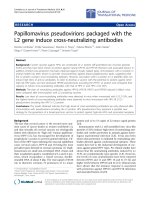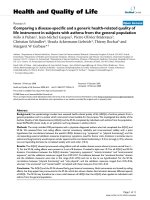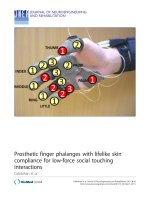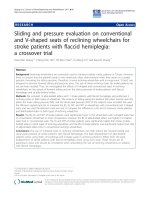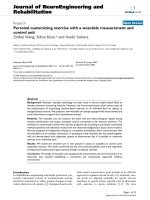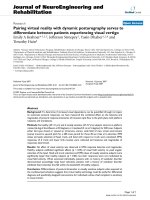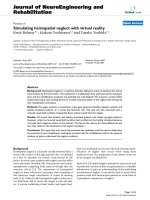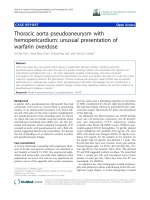báo cáo hóa học:" Alendronate (ALN) combined with Osteoprotegerin (OPG) significantly improves mechanical properties of long bone than the single use of ALN or OPG in the ovariectomized rats" pdf
Bạn đang xem bản rút gọn của tài liệu. Xem và tải ngay bản đầy đủ của tài liệu tại đây (967.33 KB, 8 trang )
RESEARC H ARTIC LE Open Access
Alendronate (ALN) combined with Osteoprotegerin
(OPG) significantly improves mechanical properties
of long bone than the single use of ALN or OPG in
the ovariectomized rats
Yan Wang
1*
, Peng Huang
1
, Pei-Fu Tang
1
, Kai-Ming Chan
2,3
and Gang Li
2,3,4*
Abstract
Background: Alendronate (ALN) is the most common form of bisphosphonates used for the treatment of
osteoporosis. Osteoprotegerin (OPG) has also been shown to reduce osteoporotic changes in both humans and
experimental animals after systemic administration. The aim of this current study was to test if the anti-resorption
effects of ALN may be enhanced when used in combination with OPG.
Objectives: To investigate the effects of ALN, OPG or combined on bone mass and bone mechanical properties in
ovariectomized (OVX) rats.
Methods: OVX rats were treated with ALN, OPG-Fc, or OPG-Fc and ALN. Biochemical markers, trabecular bone
mass, biomechanics, histomorphometry and RANKL expression in the bone tissues were examined following the
treatments.
Results: The treatment of ALN, OPG-Fc and ALN+OPG-Fc all prevented bone loss in the OVX-rats, there was no
statistical difference among the three treatment groups in terms of vertebrae BMD, mineralizing surfaces, mineral
apposition rate, BFR/ BS. The ALN+OPG-Fc treatment group had significantly increased the mechanical strength of
lumber vertebral bodies and femoral shafts when compared to the ALN and OPG-Fc treatment groups. The RANKL
protein expression in the vertebral bones was significantly decreased in the ALN and ALN+OPG-Fc treatment
groups, suggesting the combined use of OPG-Fc and ALN might have amplified inhibition of bone resorption
through inhibiting RANKL-dependent osteoclastogenesis.
Conclusion: The combined use of OPG-Fc and ALN may be a new treatment strategy for reversing bone loss and
restoring bone quality in osteoprotic disorders.
Keywords: Osteoprotegerin, Alendronate, RANKL, Osteoporosis, Ovariectomy
Background
Receptor activator of the NF-B ligand (RANKL), a key
promoting factor for osteoclast differentiation, is
expressed on osteoblastic cells. RANKL induces the dif-
ferentiation/formation of osteoclasts by binding to RANK
on the osteoclastic precursor cells. Clinical application of
RANKL inhibition has a major effect on metabolic bone
disease such as osteoporosis. Osteoprotegerin (OPG)
inhibits RANKL-RANK pathway through competitive
bindings to RAN KL. OPG deficiency resulted in severe
osteoporosis and systemic administration OPG can
reduce osteoporotic changes in both humans and experi-
mental animals [1]. However, relative large dose of OPG
are needed for systemic administration which might
cause undesired immune responses, and the high cost
may prohibit OPG wider clinical applications.
Bisphosphonates are structurally analogous to pyro-
phosphate, having greater affinity to bone that can
* Correspondence: ;
1
Department of Orthopaedic Surgery, The General Hospital of People’s
Liberation Army, Beijing, PR China
2
CUHK-Jockey Club Collaborating Centre for Sports Medicine and Health
Sciences, The Chinese University Hong Kong, Prince of Wales Hospital,
Shatin, Hong Kong, PR China
Full list of author information is available at the end of the article
Wang et al. Journal of Orthopaedic Surgery and Research 2011, 6:34
/>© 2011 Wa ng et al; licensee BioMed Central Ltd. This is an Open Access article distributed under the terms of the Creative Commons
Attribution License (htt p://creativecommons.org/licenses/by/2.0), which permits unrestri cted use, distribution, and reproduction in
any medium, provide d the original work is p roperly cited.
rapidl y acc umulate in bone tissue and ind uce osteoclast
apoptosis through inhibiting farnesyl pyrophosphate
(FPP) and GGPP bio synthesis and G-protei ns. Ale ndro-
nate (ALN) has been reported to inhibit GGPP bio-
synthesis in mevalonate pathway and the signal
transduction in the Ras-mitogen-activated protein kinase
pathwa y, thereby inhibiting RAN KL expression [2]. Our
in vitro data indicated that the comb ined use of ALN
and OPG had greater inhibitory effect on osteoclasto-
genesis than the use of OPG and ALN alone [3]. At pre-
sent there is no published data on the effect of
combined use of OPG and ALN on osteoporostic bone
loss in vivo. In the present study, we investigated the
changes of biochemical markers, trabecular bone mass
and bone biomechanics in ovariectomized (OVX) rats
with ALN, OPG treatment alone or in combination.
Methods
Rat Ovariectomy Model and Experimental Groups
12 weeks old female Sprague-Dawley rats (Experimental
Animal Center, Chinese General Hospital of PLA, Beij-
ing, China), body weight 350-400 g were used for this
experiment. The rats were maintained on commercial
rat chow with 0.95% calcium and 0.67% phosphate. Rats
were housed in a room that was maintained at 70°F
with a 12-h light/dark cycle. All animals were treated
according to the animal care guideline s, Department of
Health, PR China with the approval of the PLA General
Hospital Ethical Committee on Animal Research. Bilat-
eral ovariectomies were performed using dorsal
approach as previously reported.
Fifty rats were divided into five groups with 10 animals
in each group. Group 1: animals received sham surgery;
ovaries were exteriorized but not removed. For Groups 2,
3, 4 and 5, all animals received bilateral ovariectomies
andwaitedfor12weeks,andthenusedinthefollowing
experiments ( as detailed in Figure 1): G roup 1 (Sh am)
and Group 2 (OVX) received subcutaneous injection of
the vehicle buffer twic e weekly for 12 weeks. The other 3
groups were treated as the following: Group 3, OVX +
ALN, 28 μg/kg sub cutaneous inj ection twice/week for 12
weeks; Group 4, OVX + rhOPG-Fc, animals received 5
mg/kg rhOPG-Fc subcutaneous injection per day for 2
weeks starting from 20 weeks after the OVX surgery;
Group 5, OVX + rhOPG-Fc+ ALN, the animals were
treated twice/week with 28 μg/kg ALN subcutaneous
injection, and 5 mg/kg rhOPG-Fc was injected daily for 2
weeks starting from 20 weeks after the OVX surgery. All
animals were killed at 24 weeks following OVX surgery
and bone samples collected for further examinations.
Materials
Anti-RANKL antibody was purchased from Santa Cruz,
USA. BCA Protein assay kit was from PIERCE,
Rockford, IL, USA. Polyvinylidene difluoride membrane
filter was from Millipore, Tokyo, Japan. The ECL system
was from Amersham Biosciences, Co., Piscataway, NJ,
USA. Densitometric analysis was done with an ATTO
Densitograph (ATTO, Tokyo, Japan). ALN was obtained
from Merck C ompany. Anti-b-actin mouse monoclonal
antibodywasfromSigma,USA.rhOPG-Fc(22-201
Amino acid) was from Fuc hun Zhongnan Company,
Shanghai, PR China and the details of the characteriza-
tion of rhOPG-Fc was published previously [3].
Bone Protein Preparation and Western Blotting
The 2
nd
-5
th
caudal vertebrae were collected and pre-
pared according to Miyazaki et al [4]. In brief, all con-
nective tissues were removed and 100 mg of vertebral
bone were crushed by surgic al pliers, homogenized with
BAP buffer (50 mM Tris-HCL buffer, pH 7.5, containing
0.3 mM phenylmethyl fluoride, 1.0 mM benzamidine,
and 0.1% Triton X-100). The homogenate was centri-
fuged at 12,000 g for 20 min at 37°C. Resultant superna-
tant was used for Western blot analysis. Western
blotting was performed using a previously described
method [5]. b-actin was used as an internal standard;
Equal amount of proteins separated by electrophoresis
were transferred to 2 polyvinylidene difluoride mem-
brane filter; the proteins on the membranes were incu-
bated with antibodies of anti-RANKL and anti-b-actin
overnight at 37°C. After washing, the filters were reacted
with peroxidase-conjugated secondary antibodies for
Figure 1 Diagram shows the experimental details of treatment
in each animal group.
Wang et al. Journal of Orthopaedic Surgery and Research 2011, 6:34
/>Page 2 of 8
60 minutes at room temperature. The reactive bands
were detected with the ECL system, and the relative
intensities of the bands were calculated and expressed
by percentage change.
Urine and Serum Biochemical Assays
Rats were housed in individual metabolic cages, fasted
for 24 h before the urine samples were collected at the
day befo re surgery, 12 we eks and 24 weeks days follow-
ing OVX surgery. Twenty four-hour urine samples were
collected over sodium azide in metabo lic cages. To
minimize contamination with dietary (soybean) proteins,
the rats were starved during the collection period.
For serum collection, at each time-point, 500-1000 μl
peripheral blood was collected from the tail vein with a
plastic 1-ml heparinized syringe and further heparin (at
a final concentration of approximately 0.5 mg heparin
per ml of blood) was added to the blood. The red blood
cells were removed by centrifugation for 10 min at 4500
× g and the serum were collected. The sera were filtered
through a 0.22-μm filter for sterilization as well as in
order to remove any fragments of platelets.
Urinary levels of calcium (Ca
2+
), phosphonate (P),
creatinine (Cr) and serum levels of Ca, P were measured
by standard laboratory tests. Serum alkaline phosphatase
(ALP) and osteocalcin (OSC) were measured using
ELISA plates from R&D system according to the manu-
facturer’s instructions.
Bone Mineral Density (BMD) Measurement
At day 0 (before surgery), 12 weeks (development of
osteopenia), and 24 weeks (before killing) following
OVX surgery, whole body BMD were measured using
lunar-DXA IQ (Lunar compa ny, USA) and the BMD at
the 4
th
,5
th
and 6
th
vertabrae. The subjects were placed
on the scan table in the supine position. All scans were
performed in slow mode and analyzed using Lunar
smart scan version software with the slowest scan mode.
The measurements of the hip and vertebrae were
repeated three times, and the means were calculated.
Biomechanical Testing
The mechanical properties reflectthetruequalityof
bone and they are used as primary outcome measure-
ment parameter in this study. Three-point b ending test
described by Turner and Bur [6] was used to measure
the mechanical strength of intact femurs. The femur
was placed on custom-made struts, 9 mm apart, with a
100-N superior load cell delivered through a superior
strut directed to the mid-diaphyseal region at a rate of 1
mm/min. Load-displacement curves were recorded
using a servo-hydraulic materials testing machine (858
Mini Bionix, MTS Corp., Minneapolis, MN, USA). Data
were collected concerning peak loa d to failure, and
stiffness was calculated from load-displacement curves,
and elastic load, elastic stress and Young’ smodulus
(maximum slope of the stress-strain curve) were calcu-
lated and compared. L3 verteb rae were also measured
by vertical compression at the center along the cephalo-
caudal axis; the deformation and volume changes were
determined. Biomechanical parameters including ulti-
mate load (Fmax), maximum str ess (Fmax/cross-sec-
tional area), elastic load, elastic stress and Young’ s
modulus (maximum slope of the stress-strain curve)
were calculated and analyzed.
Bone Histomorphometry
To determine bone formation rate, rats received subcu-
taneous injections of 10 mg/kg of Calcein at 12 and 2
days before termination. Tibiae were collected and
embedded in methylmethacrylate. Serial longitudinal
sections of 4-μm, 8-μm and 200-μm thickness were cut.
4-μm sections were stained with Von Kossa and tolui-
dine blue; the 8-μm sections were mounted without
staining for measuring the bone growth rate using the
cacein labeling; the bone mineral apposition rate was
demonstrated by the distance of the two calcein labeling
lines divided by 10 days. The 200-μm thick sections
were mounted without staining for taking digital photo-
graphs. Histomorphometry measurements were per-
formed on the proximal metaphyseal region (between 2
and 4 mm distal to the growth plate/metaphysea l junc-
tion) using a digital image analysis system (Osteomea-
sure, Inc., Atlanta, GA, USA). Trabecular area,
perimeter, single- and double-labeling surfaces, osteo-
clast number, osteoid surface were measured. Trabecular
number, thickness, mineralizing surface, mineral apposi-
tional rate, BFR/surface volume (BFR/BS), and osteo-
clasts number per millimeter were calculated according
to the methods reported by Parfitt et al [7].
Statistics
The mean and standard deviation (SD) were shown. All
thedatawereanalyzedwithone-wayANOVAtestand
the inter-relationship function of the two agents, ALN
and OPG was analyzed using SPSS software (SPSS Ver-
sion 10; SPSS Inc., Chicago, IL, USA). Significant diff er-
ence was considered at p < 0.05.
Results
Effect of rhOPG-Fc and ALN Treatment on RANKL Protein
Expression
Western blot showed that RANKL protein expression in
the vertebrae was significantly increased in the OVX
group compared to all other groups (Figure 2, p < 0.01).
If we use the RANKL protein expression in the OVX
group as baseline level of 100%, the OPG-Fc treatment
reduced the RANK L protein expression to 60% of
Wang et al. Journal of Orthopaedic Surgery and Research 2011, 6:34
/>Page 3 of 8
baseline level; ALN treatment further reduced the
RAN KL prot ein expression to 40% of the baseline level;
the RANKL protein expression in the OPG-Fc+ALN
treated group and the sham control group was similar
and the lowest among the groups, only 20% of the OVX
group baseline le vel, however there is no statistical dif-
ferences among the treatment groups (Figure 2).
Changes of Biochemical Markers in Urine and Serum
The urinary excretion of calcium ion was similar in all
groups at 12 weeks post OVX, but it was significantly
increased in the OVX group at 24 weeks compare to
other groups (Table 1). There was no signi ficant change
in urinary excretion of phosphates and creatinine (not
shown). Serum osteocalcin level in the OVX group
increased approximately 46% comparing to the sham
group at 12 weeks post OVX and remained elevated at
this level until 24 weeks post OVX. However, the serum
osteocalcin level in a ll the treatment groups decreased
after 12 weeks treatment when comparing to the serum
osteocalcin level before treatment: the OPG-Fc group
decreased 35% (p < 0.05); ALN group decreased 23%
(p < 0.05) while the OPG+ALN group decreased 58%
(p < 0.05, Figure 3), however there was no statistical dif-
ference among all the treatment groups.
Changes of Bone Mineral Density (BMD)
The BMD of L4-L6 lumbar vertebrae in all groups was
similar before OVX and decreased about 20% at 12 weeks
following OVX surgery in all groups compare to that of
sham group. At 12 weeks af ter treatment (24 weeks after
OVX surgery), the BMD of L4-L6 verteb rae in the OPG-
Fc, ALN, OPG-Fc+ALN and sham control groups was sig-
nificantly higher than that i n the OVX g roup (Table 2),
but there was no statistical difference among the OPG-Fc,
ALN, OPG-Fc+ALN and sham control groups.
Figure 2 Western blot analysis showed the RANKL protein
expression in the vertebral bones at 12 weeks after receiving
different treatments (24 weeks post-OVX). RANKL protein
expression in the vertebrae was significantly increased in the OVX
group compared to all other groups. If we use the RANKL protein
expression in the OVX group as baseline level of 100%, the OPG-Fc
treatment reduced the RANKL protein expression to 60% of baseline
level; ALN treatment further reduced the RANKL protein expression
to 40% of the baseline level; the RANKL protein expression in the
OPG-Fc+ALN treated group and the sham control group was similar
and was lowest among the groups, only 20% of the OVX group
baseline level. *p < 0.05 when compared to the OVX group and
there was no statistical difference among the tree treatment groups.
Table 1 Urinary calcium excretion (mmol/L) in different
treatment groups over time
Treatment Groups 12 wks after OVX
(before treatment)
24 wks after OVX
(12 wks after treatment)
Sham 1.61 ± 0.30 1.81 ± 0.45
OVX 1.69 ± 0.25 2.11 ± 0.39
a
OVX+ALN 1.67 ± 0.30 1.89 ± 0.33
OVX+OPG-Fc 1.56 ± 0.31 1.43 ± 0.35
b
OVX+ALN+OPG-Fc 1.51 ± 0.40 1.48 ± 0.45
b
(a): Group had higher value than that of all other groups at the given time,
p < 0.05.
(b): Group had significantly lower value than that of Sham, OVX and OVX
+ALN groups, p < 0.05.
Treatment Grou
p
s
6KDP 29; $/1 23*)F 23*
)F$/1
Serum Osteocalcin (ng/ml)
#
#
#
Figure 3 At 24 weeks p ost OVX (12 weeks following
treatment), serum osteocalcin level decreased by 23% to the
baseline level (sham group) in the ALN-treated group; 35% to
the baseline level in the OPG-Fc-treated group; and 58% to the
baseline level in the OPG+ALN-treated group, which was
significantly reduced (#p < 0.05, Student’s t-test) comparing to
the sham group. There was no statistical difference among the
three treatment groups.
Wang et al. Journal of Orthopaedic Surgery and Research 2011, 6:34
/>Page 4 of 8
Mechanical Properties Measurements
At 24 weeks post OVX, the OVX group had signifi-
cantly reduced the mech anical strength of L3 vertebrae,
including ultimate load (-31%, Table 3) and ultimate
stress (-41%, Table 3) compare to all other groups. The
administration of ALN and OPG-Fc alone showed
trends of minimizing loss of mechanical properties of
vertebrae, but o nly the OPG-Fc +A LN group had
achieved statistical significance compared to the OVX
group (Table 3). The similar findings were seen in the
mechanical properties of the femoral shaft: OVX
reduced the ultimate load (-13%) and strength (-15%)
significantly when compared to the sham group. At 24
weeks post-OVX, the values of ultimate force and ulti-
mate strength were higher in the A LN, OPG-Fc and
OPG-Fc+ALN gr oups than that in the OVX group,
however only the OPG-Fc+ALN group achieved statisti-
cal significance (Table 3).
Histomorphometric Measurements
Compared to the sham group, OVX group had a signifi-
cant reduction in trabecular area, trabecular thickness,
and increase in mineralizing surface and mineral apposi-
tion rate at 24 week post-OVX (Table 4). While the Tb.
Ar% and trabecular thickness in the OVX+OPG-Fc,
OVX+ALN and OVX+OPG-Fc+ALN groups were
rea ched to the similar level or higher than that of sham
and all were significantly higher than that in the OVX
group at 24 weeks post-OVX; the OVX+OPG-Fc+ALN
group had the highest Tb.Ar%, which was significantly
higher (p < 0.05) than that of all other groups, including
the sham group. OVX also increased the rate of bone
turnover (BFR/BS) by 55% and osteoclasts number by
211% in the OVX group comparing to the sham group.
For ALN-, OPG-Fc and OV X+OPG -Fc+ALN group, the
mineral apposition rate, BFR/BS and osteoclasts number
were significantly reduced than that in the OVX group
at 24 weeks post-OVX. In the ALN+OPG-Fc group, the
osteoclast number was lowest among all the groups and
it was statistically significant when compared to all
other groups, including the sham group. There was no
significant difference of the mineralizing surface, mineral
apposition rate and BRF/BS among the OPG-Fc, ALN
and ALN+OPG-Fc groups (Table 4).
Histology Examination
On the microphotograp hs of the grounded sections of
tibial metaphyseal regions, the trabecular bone volume
was highest in the OPG-Fc+ALN group; followed by the
Sham, OPG-Fc and ALN groups which were similar,
and the OVX group had significant less bone volume
than any of the groups (Figure 4, top panel). The histo-
logical sections of proximal tibial regions revealed that
the trabecular volume and thickness were greatly
reduced in the OVX group (Figure 4, bottom panel)
compared to the sham group; whereas the trabecular
volume and thickness in the ALN group and OPG
group were sim ilar to that of sham group and the OPG-
Fc+ALN group had more trabecular volume than that
of sham group (Figure 4, bottom panel).
Discussion
Postmenopausal osteoporosis is a metabolic bone dis-
ease associated with estrogen deficiency and aging, hav-
ing reduced bone mass that accounts for increased
fracture risk. Antiresorptive agents have been developed
and used clinically to suppress trabecular bone loss.
OPG is a member of the tumour necrosis factor (TNF)
receptor super-family, which negatively regulates osteo-
clastogenesis [8,9]. OPG inhibit osteoclast precursors
differentiation into mature osteoclasts [10] and inhibits
bone resorption in a dose-dependent manner [11].
RANKL is a member of the membrane-associated TNF
Table 2 Changes of BMD in L4-L6 vertebrae in different
treatment groups over time
Groups L4-L6 Vertebrae Mean BMD (g/cm
2
)
Before OVX 12 weeks
post-OVX
24 weeks
post-OVX
Sham 0.21 ± 0.046 0.34 ± 0.023 0.37 ± 0.017
OVX 0.22 ± 0.039 0.27 ± 0.039 0.27 ± 0.022
a
OVX+ALN 0.21 ± 0.043 0.27 ± 0.039 0.37 ± 0.029
OVX+OPG-Fc 0.19 ± 0.038 0.23 ± 0.025 0.38 ± 0.026
OVX+ALN+OPG-Fc 0.19 ± 0.034 0.27 ± 0.020 0.36 ± 0.027
(a): Group had significantly lower value than that of all the other groups at
the given time, p < 0.05.
Table 3 Mechanical properties of L3 vertebra and
femoral shaft at 24 weeks post-OVX
Groups (L3 vertebra) Ultimate load
(N)
Ultimate stress
(N/mm
2
)
Sham 314.89 ± 22.87 46.30 ± 2.65
OVX 217.46 ± 33.04
a
27.88 ± 4.23
a
OVX+ALN 294.75 ± 25.58 37.79 ± 2.78
OVX+OPG-Fc 275.30 ± 28.77 35.29 ± 1.35
OVX+ALN+OPG-Fc 312.91 ± 41.76
b
40.12 ± 2.53
b
Groups (Femoral
shaft)
Ultimate load
(N)
Ultimate stress
(N/mm2)
Sham 125.79 ± 11.19 187.14 ± 33.01
OVX 104.88 ± 6.21
a
146.57 ± 12.75
a
OVX+ALN 130.83 ± 9.11 179.91 ± 13.01
OVX+OPG-Fc 124.72 ± 6.78 174.65 ± 12.15
OVX+ALN+OPG-Fc 127.55 ± 7.49
b
176.89 ± 17.44
b
Data were presented as mean ± SEM.
(a): Group had significantly lower value than that of the sham group at the
given time, p < 0.01.
(b): Group had significantly higher value than that of the OVX group at the
given time, p < 0.01.
Wang et al. Journal of Orthopaedic Surgery and Research 2011, 6:34
/>Page 5 of 8
ligand family that induces osteoclasts differentiation
from the haemopoietic precursors and stimulates their
bone resorptive activities [12,13]. OPG is a soluble
decoy receptor for RANKL, it inhibits osteoclast differ-
entiation and bone resorption via direct binding to
OPG-expressed ligand secreted by osteoblasts or stromal
cells [14]. The deficiency of OPG genes resulted in
severe osteoporosis in both human and experimental
animals [15,16], while systemic admini stration of rhOPG
prevented osteopenia and ovariectomy-induced bone
loss [1,14,15]. Howeve r, large dose of rhOPG is needed
for a prolonged period when treating osteoporosis, the
high cost of OPG and possible adverse immune reac-
tions associated with the use of greater dose of OPG
hinders the wider clinical application of OPG.
Alendronate (AL N, 4-amino-1-hydroxybutyl idene
bisphosphonate) is an amino bisphosphonate that has
been developed for the treatment of osteolytic bone dis-
orders such as giant cell tumor and osteoporosis. In
vivo, alendronate has been localized at sites of bone
resorption and inhibited osteoclastic activity, prevented
and reversed the bone loss induced by estrogen defi-
ciency, and maintained the mechanical strength of ver-
tebrae in ovariectomized rats. The administration of
ALN resulted in increased femoral cortical bending load
as well as increased vertebra l ultimate compressive load
commensurate in a dose dependent manner. ALN has
been found to lead to poor cell functioning or pro-
grammed cell death of osteoclasts, and the mechanism
is through the inhibition of geranylgeraniol (a cell-
permeable form of GGPP) and farnesol (a cell-perme-
able form of FPP) [17]. As a potent inhibitor of bone
resorption, ALN has been proven to produce sustained
reduction in biochemical markers of bone remodeling;
while, consistent dose-related increases in bone mineral
density in a variety of populations, especially elderly
women [18].
We have used the OVX rat model which has been
widely used to investigate estrogen-deficiency associated
osteoporosis [19]. We have waited for 12 weeks follow-
ing OVX t o allow the development of osteopenic
changes, and then the intervention treatments were
given for 12 weeks to t est the effect on preventing
further bone loss.
It has been shown that administration of ALN (15 μg/
kg) in the OVX rats had significantly increased bone
mass and strength in OVX rats [20]. The dose of ALN
used in this study was 28 μg/kg, which was nearly twice
as much as the reported dose (15 μg/kg), and the ani-
mals tolerated well. The dose of OPG-Fc used in this
study was 5 mg/kg, the same dose was reported by Cap-
parelli et al. 2003 [21], whom showed that a single intra-
venous injection of rhOPG-Fc (5 mg/kg) in young
growing rats causes significant gains in bone volume
and density, which were associated with rapid and sus-
tained suppression of osteoclastic bone resorption. We
Table 4 Histomorphometric data at 24 weeks post-OVX in metaphyseal regions of the tibiae
Treatment
Group
Tb.Ar (%) Trabecular
thickness (μm)
Min. surface
(%)
Mineral apposition rate
(μm/day)
BFR/BS
(μm/day)
Osteoclast number
(no/mm)
Sham 49.0 ± 9.23
a
74.2 ± 11.34
a
21.4 ± 3.3
a
0.7 ± 0.13
a
16.2 ± 1.45
a
0.36 ± 0.03
a
OVX 11.6 ± 5.81 45.2 ± 10.61 33.2 ± 4.6 1.2 ± 0.1 35.7 ± 2.30 1.12 ± 10.61
OVX+ALN 59.7 ± 8.29
a
90.0 ± 17.65
a,b
28.1 ± 1.44
a
0.9 ± 0.0
a
24.6 ± 1.11
a
0.24 ± 0.04
a,b
OVX+OPG-Fc 44.5 ± 6.72
a
71.1 ± 27.19
a
27.8 ± 2.17
a
0.7 ± 0.0
a
23.1 ± 2.11
a
0.15 ± 0.04
a,b
OVX+ALN
+OPG-Fc
62.3 ± 9.34
a, b
93.7 ± 13.97
a,b
22.1 ± 3.71
a
0.6 ± 0.09
a
17.7 ± 1.94
a
0.05 ± 0.00
a,b
Data were presented as mean ± SEM.
(a): Group had significantly higher or lower value than that of the OVX group, p < 0.05.
(b): Group had significantly higher or lower value than that of the sham grou p, p < 0.05.
A: SHAM B: OVX C: ALN D: OPG-Fc E: OPG-Fc+AL
N
1mm
100 μm
Figure 4 Representatives of the distal tibiae macroscopic and
histological appearances of different groups at 24 weeks post-
OVX. Top panel represents digital photographs of 200-μm thick
sections (bar = 1 mm); bottom panel are representatives H&E
histological sections from the boxed metaphyseal regions of the
top panel (bar = 100 μm). The trabecular bone volume at the
metaphyseal region of the tibiae in the OVX group had reduced
markedly; both OPG-Fc and ALN-treated groups had greater bone
volumes than that in the OVX group; and the OPG-Fc+ALN-treated
group had the greatest bone volumes, which appeared to be even
greater than that in the sham group.
Wang et al. Journal of Orthopaedic Surgery and Research 2011, 6:34
/>Page 6 of 8
used rhOPG-Fc produced in yeast contains 180 residues
from mature human OPG (amino acid 22-201) and 232
residues from the Fc protein of human IgG1, which has
a longer circulating time due to its enhanced endothelial
recycling and high molecular weight.
The main purpose of the current study was to test if
the co-treatme nt of OPG-Fc with ALN will have any
additive effect. In particular we were interested to see
the effect of OPG-Fc in the animals which have already
received ALN treatment as this has more clinical rele-
vance for patients already on ALN treatment. The rea-
sons we chose to use 2 weeks OPG-Fc treatment are
that (1) Our pilot animal study has demonstrated that 5
mg/kg/day OPG-Fc injection for two weeks had anti-
resporptive and anabolic effects in rats. (2) We have
concerns of potential immunogenic reactions of rats to
rhOPG-Fc when it was given for longer duration than 2
weeks. In the current study, we have administrated the
rhOPG- Fc (5 mg/kg) by subcutaneous injecti on per day
for 2 weeks, and the animals tolerated well and no
adverse effect was observed.
The treatment of ALN, OPG-Fc and ALN+OPG-Fc all
had anti-catabolic effects and prevented further bone
loss in the OVX-rats. There was no statistical difference
among the three treatment groups in terms of vertebrae
BMD, mineralizing surfaces, mineral apposition rate,
BFR/BS, suggesting that ALN and OPG-Fc treatment
alone would be good enough to prevent bone loss in
osteoporotic conditions. But only the ALN+OPG-Fc
treatment group had significantly enhanced the vertebral
anti-compressing strength and femoral shaft maximal
loading for failure, suggesting the combined use of ALN
and OPG-Fc could further enhance bone mechanical
properties in addition to the bone mass. Since the
mechanical testing is the current golden standard for
accessing bone quality, the data suggested that the com-
bined use of OPG-Fc and ALN in the current study not
only prevented further bone loss (as the ALN and OPG-
Fc treatment did), it also reversed bone quality following
OVX-induced bone loss. The data also suggested that it
maybebeneficialforthepatientswhowerealreadyon
ALN treatment to receive a short duration of OPG-Fc
treatment, which may further enhance long bone
mechanical properties.
We have showed RANKL protein expression in the
vertebral bones was significa ntly decreased in the ALN
and ALN+OPG- Fc treatment groups and OPG-Fc treat-
ment for 2 weeks alone did not significantly affect
RANKL protein expression. Since the OPG-Fc binds to
RANKL directly to inhibit osteoclastogesis and it not
necessarily has any effect on RANKL protein expression.
We believe that the complex OPG-RANKL is still pre-
sent under ALN treatment, but the RANKL expression
was significantly decreased, so that additional OPG-F c
in the presence of ALN, even in a short duration (2
weeks) resulted in partial gain of bone mass and signifi-
cantly improved bone structures, as indicated by the
mechanical testing data.
One possible explanation on the greater anti-resorp-
tion effect of using OPG-Fc and ALN in combinat ion is
the amplified inhib itory effects of RNAKL function.
rhOPG-Fc have competitive binding to RANKL whereas
ALN leaded to a reduced expression of RANKL protein
in the trabecular bone, thus the combination of the two
treatments results a greater inhibitory effect on RANKL-
dependent osteoclastogenesis and a positive balance
towards bone formation cycle. ALN may have also
inhibited farnesyl pyrophosphate synthesis or other
enzymes of the mevalonate pathway which may lead to
decrease GGPP biosynthesis and inhibit signal transduc-
tion in the Ras-MEK-ERK pathway, which is important
in maintaining normal osteoclast function [22]. Small
GTPases, such as Ras, Rho and Rac, are important for
maintaining osteoclasts morphology and activity and
lacking of these enzyme s may lead to impaired function
of osteoclasts [23-25]. Therefore, the combined use of
OPG-FcandALNmighthavepushedthebalanceof
bone remodeling cycle towardsosteogenesisthrough
amplified inhibition of osteoclastogenesis.
There are limitations of the current study, that the
study duration was relatively short and we only tested
one regime of rhOPG-Fc administration (by subcuta-
neous injection for 2 weeks) and the dose of rhOPG-Fc
and ALN used in this study may not be the optimal
one. Nonetheless, the current study serves as a proof-of-
concept study and the exact mechanisms for how ALN
reduce RANKL expression in bone; the optimal dosing
and timing for ALN and OPG-Fc and the longer time
effect of ALN+OPG-Fc on bone remodeling/formation
needs future investigations.
In conclusion, we have demonstrated that co-treat-
ment of ALN and OPG-Fc, through a short duration (2
weeks), has significantly improved the mechanical prop-
erties of femurs and vertebral bodies of the OVX rats
compared to ALN and OPG-Fc single treatment groups.
The combined use of rhOPG-Fc and ALN may be a
new treatment strategy for preventing bone loss and
reversing bone mass and quality in osteoprotic disor-
ders, and it deserves further investigations.
Acknowledgements
This project is supported by a national 863 high-technology project grant
(2002AA214081) of PR China. We thank Merck Company, USA for providing
the Alendronate and Fuchun Zhongnan Biotech Company, Shanghai, PR
China, for providing rhOPG-Fc for this study.
Author details
1
Department of Orthopaedic Surgery, The General Hospital of People’s
Liberation Army, Beijing, PR China.
2
CUHK-Jockey Club Collaborating Centre
Wang et al. Journal of Orthopaedic Surgery and Research 2011, 6:34
/>Page 7 of 8
for Sports Medicine and Health Sciences, The Chinese University Hong Kong,
Prince of Wales Hospital, Shatin, Hong Kong, PR China.
3
Department of
Orthopaedics & Traumatology and Stem Cells and Regenerative Medicine
Laboratory, Li Ka Shing Institute of Heath Sciences, The Chinese University
Hong Kong, Prince of Wales Hospital, Shatin, Hong Kong, PR China.
4
CUHK-
Jian University Joint Laboratory, MOE Key Laboratory for Regenerative
Medicine, School of Biomedical Sciences, The Chinese University of Hong
Kong, Shatin, Hong Kong, PR China.
Authors’ contributions
YW, PH and PFT carried out the animal experiments and participated in
experimental design and the first draft of the manuscript. KMC helped with
study design and discussion. GL and YW were involved in the study design
and overall coordination, and YW was the grant holder. All authors read and
approved the manuscript.
Competing interests
The authors declare that they have no competing interests.
Received: 11 December 2010 Accepted: 13 July 2011
Published: 13 July 2011
References
1. Bateman TA, Dunstan CR, Ferguson VL, Lacey DL, Ayers RA, Simske SJ:
Osteoprotegerin mitigates tail suspension-induced osteopenia. Bone
2000, 26:443-449.
2. Nishida S, Tsubaki M, Hoshino M: Nitrogen-containing bisphosphonate,
YM529/ONO-5920 (a novel minodronic acid), inhibits RANKL expression
in a cultured bone marrow stromal cell line ST2. Biochem Biophys Res
Commun 2005, 328:91-97.
3. Huang P, Wang Y, Chi Z, Yang Z, Ni J, Yang W, Wang R: In vitro study of
combination rhOPG-FC and Alendronate on inhibiting
osteoclastogenesis. Chin J Surg 2005, 43:812-816.
4. Miyazaki S, Igarashi M, Nagata A, Tominaga Y, Onodera K, Komoda T:
Development of immunoassays for type-5 tartrate-resistant acid
phosphatase in human serum. Clin Chim Acta 2003, 329:109-115.
5. Nosjean O, Koyama I, Goseki M, Roux B, Komoda T: Human tissue non-
specific alkaline phosphatases: Sugarmoiety-induced enzymic and
antigenic modulations and genetic aspects. Biochem J 1997, 21:7-303.
6. Turner CH, Burr DB: Basic biomechanical measurements of bone: A
tutorial. Bone 1993, 14:595-690.
7. Parfitt AM, Drezner MK, Glorieux FH, Kanis JA, Malluche H, Meunier PJ,
Ott SM, Recker RR: Bone histomorphometry: Standardization of
nomenclature, symbols, and units. J Bone Miner Res 1987, 2:595-610.
8. Simonet WS, Lacey DL, Dunstan CR, Kelley M, Chang MS, Luthy R,
Nguyen HQ, Wooden S, Bennett L, Boone T, Shimamoto G, DeRose M,
Elliott R, Colombero A, Tan HL, Trail G, Sullivan J, Davy E, Bucay N, Akatsu T,
Murakami T, Nishikawa M, Ono K, Shinomiya N, Tsuda E, Mochizuki S,
Yamaguchi K, Kinosaki M, Higashio K, Yamamoto M, Motoyoshi K, Nagata N:
Osteoclastogenesis inhibitory factor suppresses osteoclast survival by
interfering in the interaction ofstromal cells with osteoclast. Biochem
Biophys Res Commun 1998, 250:229-234.
9. Tsuda E, Goto M, Mochizuki S, Yano K, Kobayashi F, Morinaga T, Higashio K:
Isolation of a novel cytokine from human fibroblasts that specifically
inhibits osteoclastogenesis. Biochem Biophys Res Commun 1997,
234:137-142.
10. Akatsu T, Murakami T, Nishikawa M, Ono K, Shinomiya N, Tsuda E,
Mochizuki S, Yamaguchi K, Kinosaki M, Higashio K, Yamamoto M,
Motoyoshi K, Nagata N: Osteoclastogenesis inhibitory factor suppresses
osteoclast survival by interfering in the interaction of stromal cells with
osteoclast. Biochem Biophys Res Commun 1998, 250:229-234.
11. Atkins GJ, Bouralexis S, Haynes DR, Graves SE, Geary SM, Evdokiou A,
Zannettino ACW, Hay S, Findlay DM: Osteoprotegerin inhibits osteoclast
formation and bone resorbing activity in giant cell tumors of bone. Bone
2001, 28:370-377.
12. Lacey DL, Timms E, Tan HL, Kelley MJ, Dunstan CR, Burgess T, Elliott R,
Colombero A, Elliott G, Hsu H, Sullivan J, Hakins N, Davy E, Capparelli C,
Eli A, Qian YX, Kaufman S, Sarosi I, Shalhoub V, Senalddi G, Guo J,
Delaney J, Boyle WJ: Osteoprotegerin ligand is a cytokine that regulates
osteoclast differentiation and activation. Cell 1998, 93:165-176.
13. Tsukii K, Shima N, Mochizuki N, Yamaguchi K, Kionosaki M, Yano K,
Shibata O, Udagawa N, Yasuda H, Suda T, Higashio K: Osteoclast
differentiation factor mediates an essential signal for bone resorption
induced by 1, 25-dihydroxyvitamin D3, prostaglandin E2, or parathyroid
hormone in the microenvironment of bone. Biochem Biophys Res
Commun 1998, 246
:337-341.
14. Udagawa N, Takahashi N, Yasuda H, Mizuno A, Itoh K, Ueno Y, Shinki T,
Gillespie MT, Martin TJ, Higashio K, Suda T: Osteoprotegerin produced by
osteoblasts is an important regulator in osteoclast development and
function. Endocrinology 2000, 141:3478-3484.
15. Mizuno A, Amizuka N, Irie K, Murakami A, Fujise N, Kanno T, Sato Y,
Nakagawa N, Yasuda H, Mochizuki S, Gomibuchi T, Yano K, Shima N,
ashida N, Tsuda E, Morinaga T, Higashio K, Ozawa H: Severe osteoporosis
in mice lacking osteoclastogenesis inhibitory factor/osteoprotegerin.
Biochem Biophys Res Commun 1998, 247:610-615.
16. Yano K, Tsuda E, Washida N, Kobayashi F, Goto M, Harada A, Ikeda K,
Higashio K, Yamada Y: Immunological characterization of circulating
osteoprotegerin osteoclastogenesis inhibitory factor: increased serum
concentrations in postmenopausal women with osteoporosis. J Bone
Miner Res 1999, 14:518-527.
17. Van Beek E, Lowik C, Van der Pluijm G, Papapoulos S: The role of
geranylgeranylation in bone resorption and its suppression by
bisphosphonates in fetal bone explants in vitro: a clue to the
mechanism of action of nitrogen-containing bisphosphonates. J Bone
Miner Res 1999, 14:722-729.
18. Bone HG, Hosking D, Devogelaer JP, Tucci JR: Ten years’ experience with
Alendronate for osteoporosis in postmenopausal women. N Engl J Med
2004, 350:1189-99.
19. Mosekilde L, Danielsen CC, Knudsen UB: The effect of aging and
ovariectomy on the vertebral bone mass and biomechanical properties
of mature rats. Bone 1993, 14:1-6.
20. Fuchs RK, Shea M, Durski SL, Winters-Stone KM, Widrick J, Snow CM:
Individual and combined effects of exercise and alendronate on bone
mass and strength in ovariectomized rats. Bone 2007, 41:290-296.
21. Capparelli C, Morony S, Warmington K, Adamu S, Lacey D, Dunstan CR,
Stouch B, Martin S, Kostenuik PJ: Sustained antiresorptive effects after a
single treatment with human recombinant osteoprotegerin (OPG): a
pharmacodynamic and pharmacokinetic analysis in rats. J Bone Miner Res
2003, 18:852-858.
22. Bergstrom JD, Bostedor RG, Reszka AA, Rodan G: Alendronate is a specific,
nanomolar inhibitor of farnesyl diphosphate synthase. Arch Biochem
Biophys 2000, 373:231-241.
23. Zhang FL, Casey PJ: Protein prenylation: molecular mechanisms and
functional consequences. Annu Rev Biochem 1996, 65:241-269.
24. Zhang D, Udagawa N, Nakamura I: The small GPT-binding protein, Rho
p21, is involved in bone resorption by regulating cytoskeletal
organization in osteoclasts. J Cell Sci 1995, 108:2285-2292.
25. Marshall CJ: Protein prenylation: a mediator of protein-protein
interactions. Science 1993, 259:1865-1866.
doi:10.1186/1749-799X-6-34
Cite this article as: Wang et al.: Alendronate (ALN) combined with
Osteoprotegerin (OPG) significantly improves mechanical properties of
long bone than the single use of ALN or OPG in the ovariectomized rats.
Journal of Orthopaedic Surgery and Research 2011 6:34.
Submit your next manuscript to BioMed Central
and take full advantage of:
• Convenient online submission
• Thorough peer review
• No space constraints or color figure charges
• Immediate publication on acceptance
• Inclusion in PubMed, CAS, Scopus and Google Scholar
• Research which is freely available for redistribution
Submit your manuscript at
www.biomedcentral.com/submit
Wang et al. Journal of Orthopaedic Surgery and Research 2011, 6:34
/>Page 8 of 8
